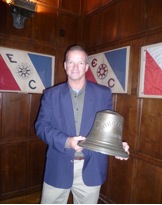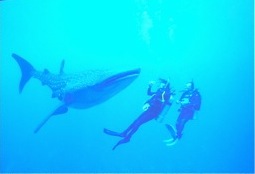Images of long-lost shipwrecks, whale sharks, first-century marble columns, diving into blue holes in the Bahamas, and attempting to save the world's iconic fishes --- just an ordinary day for extraordinary explorers visiting New York City.
Incorporated in 1905, and dedicated to the advancement of field research and scientific exploration, the Explorer's Club hosted "Sea Stories" on Nov. 19th, at their NYC based headquarters, 46 East 70th Street.
Explorers, divers, scientists, filmmakers, writers, and yes, the general public was invited to hear about scientific adventures during a 10-hour immersion of presentations, conversations, and food and drink. "It's like the pages of National Geographic coming to life", said one guest, Dan Lieb, a NJ historical diver.
The following is a brief synopsis of each explorer's presentation:
Steve McPhee, a commercial dive r, marine surveyor, and explorer from the Bahamas, revealed the story of the three-masted barque, the Dorothea, last sighted adrift in 1913 off of Bermuda. This ghost ship and her crew remained a mystery, until McPhee began to trace her origins from Hamburg, Germany, after uncovering her 55-pound bell almost 100 years later. McPhee was able to research the crew, its cargo and the threats to her demise at sea.
r, marine surveyor, and explorer from the Bahamas, revealed the story of the three-masted barque, the Dorothea, last sighted adrift in 1913 off of Bermuda. This ghost ship and her crew remained a mystery, until McPhee began to trace her origins from Hamburg, Germany, after uncovering her 55-pound bell almost 100 years later. McPhee was able to research the crew, its cargo and the threats to her demise at sea.
Dr. Rachel Graham, from the Wildlife Conservation Society and Director of the Gulf and Caribbean Sharks and Rays Program, focused on the migration patterns of whales sharks and rays. Whale sharks are filter feeders, eating copious amounts of copepods, fish eggs, and small fish and invertebrates using a sucking and pump action behavior with the mouth wide open. Delicate gill rakers function like a sieve, capturing planktonic (free-floating) prey. The whale sharks are tagged with pop-up archival transmitters that record and send data on water depth, temperature, and light level to satellites. As Dr. Graham says, "the animals send us an email of where it's been". The whale sharks' deep dives during the day to over 60 feet may be a form of thermoregulation, or receiving navigational cues (stronger magnetic force the deeper you go) or finding sources of food. Major threats to whale sharks include people finning them as a status symbol, strikes with ships, and predation by great white sharks.
 Mark Gordon, President and Chief Operating Officer for Odyssey Marine Exploration, manages a 25-30 million dollar a year operation engaged in shipwreck, resource and archeological recovery. Gordon discussed the following seven keys for a successful exploration, which applies to achieving many goals in most disciplines:
Mark Gordon, President and Chief Operating Officer for Odyssey Marine Exploration, manages a 25-30 million dollar a year operation engaged in shipwreck, resource and archeological recovery. Gordon discussed the following seven keys for a successful exploration, which applies to achieving many goals in most disciplines:
1) Clean vision and plan
2) Build your network
3) Recruit top talent with meaningful input
4) Equip your team with the best tools and techniques
5) Expect and prepare for adversity
6) Balance risk and return
7) Be passionate about what you do
In conclusion, a good strategy helps to achieve success in your adventures.
Dr. Debbie Carlson, Professor, Texas A & M University, is an underwater archaeologist specializing in ancient Mediterranean history and architecture. Carlson discovered bronze coins and marble cross sections of columns (drums) from a ship that sunk off of Turkey in the first century B.C. Following the transport and assembly of the marble drums to form a column, the carving and fluting of the marble was then done onsite, usually for a temple. Amphoras, large ceramic jugs that carried the valued commodities for transport, differ from one region to another, each with its own distinctive clay type and style. Dating the material is accomplished by using isotope carbon analysis of the stone, based on the rate of decay of the carbon, which is found in the earth, in the air, and in the water.
Dr. Kenny Broad, Professor, University of Miami's Rosenstiel School of Marine and Atmosphere Science, has been featured on National Geographic and PBS for his exploration of the Blue Holes of Bermuda. Caves are one of the least explored underwater habitats, requiring unique gear, great skills, and taking great risks. Divers must squirm through nearly invisible crevices, with anoxic (lack of oxygen) rotten egg-like smelling sediments surrounding you. But the scenery is unbelievable and dreamlike. Similar to terrestrial caves, sea caves have stalactites (top) and stalagmites (bottom). These slowly growing pillar formations form when water dissolves the limestone bedrock. The growth rate may be from half an inch to 3.5 inches (1 to 9 cm) every 1,000 years! Broad uses the term "bioprospecting" to find new life forms that live in extreme habitats: maybe on a microbial mat, rich in hydrogen sulfide, and tainted pink, from a pigment inside the bacteria. A perfect place for fossilization, Broad found ancient turtles, crocodiles, owls, and human remains in these blue holes, along with discovering unfamiliar living forms of life without eyes, or pigments.
Dr. Kevin Weng, Oceanographer from the University of Hawaii, has been studying the migration of sharks and fish, and in particular, a boney fish called the Napoleon Wrasse. Adult great white sharks have long migrations, from California to Hawaii, while the juveniles stay closer to the coastline travelling between the U.S. and Mexico. The Napoleon Wrasse, a rare and beautiful slow-moving fish, has a small home range within ½ mile off of the Palmyra Atoll. This atoll is a pristine remote island near the Equator, just south of the Hawaiian Islands. The Palmyra Atoll was purchased by the Nature Conservancy and is now a U.S. Fish & Wildlife Refuge for scientific research. The Napoleon Wrasse feeds on the crown-of thorns sea star, which is a major predator to coral reefs. The decline of the Napoleon Wrasse will result in greater losses of coral reefs, upsetting the predator-prey balance. Understanding the breeding and migration habits of endangered species will help to develop protective measures to ensure their survival.
Each time you see pictures of exotic places, maps of continents or ocean currents, read data points, or stories of adventure, think of all the work, personal sacrifice, courage and determination of both past and present explorers. Teachers... create an explorers day and have your students research and report to the class.
Visit the Explorer's Club website for information on special events and lectures that are open to the public. The Explorer's Club encourages and provides support for young budding scientists in high schools and colleges through the Youth Activities Fund. The Exploration Fund is designed for graduate students to assist in field research leading to advanced degrees. Visit these websites for more information on marine science and exploration.
www.shipwreck.net
www.wildlifetracking.org
www.whaleshark.org
www.Explorers.org
www.nysmea.org
Get out there and explore!
 r, marine surveyor, and explorer from the Bahamas, revealed the story of the three-masted barque, the Dorothea, last sighted adrift in 1913 off of Bermuda. This ghost ship and her crew remained a mystery, until McPhee began to trace her origins from Hamburg, Germany, after uncovering her 55-pound bell almost 100 years later. McPhee was able to research the crew, its cargo and the threats to her demise at sea.
r, marine surveyor, and explorer from the Bahamas, revealed the story of the three-masted barque, the Dorothea, last sighted adrift in 1913 off of Bermuda. This ghost ship and her crew remained a mystery, until McPhee began to trace her origins from Hamburg, Germany, after uncovering her 55-pound bell almost 100 years later. McPhee was able to research the crew, its cargo and the threats to her demise at sea. Mark Gordon, President and Chief Operating Officer for Odyssey Marine Exploration, manages a 25-30 million dollar a year operation engaged in shipwreck, resource and archeological recovery. Gordon discussed the following seven keys for a successful exploration, which applies to achieving many goals in most disciplines:
Mark Gordon, President and Chief Operating Officer for Odyssey Marine Exploration, manages a 25-30 million dollar a year operation engaged in shipwreck, resource and archeological recovery. Gordon discussed the following seven keys for a successful exploration, which applies to achieving many goals in most disciplines:
Leave a comment